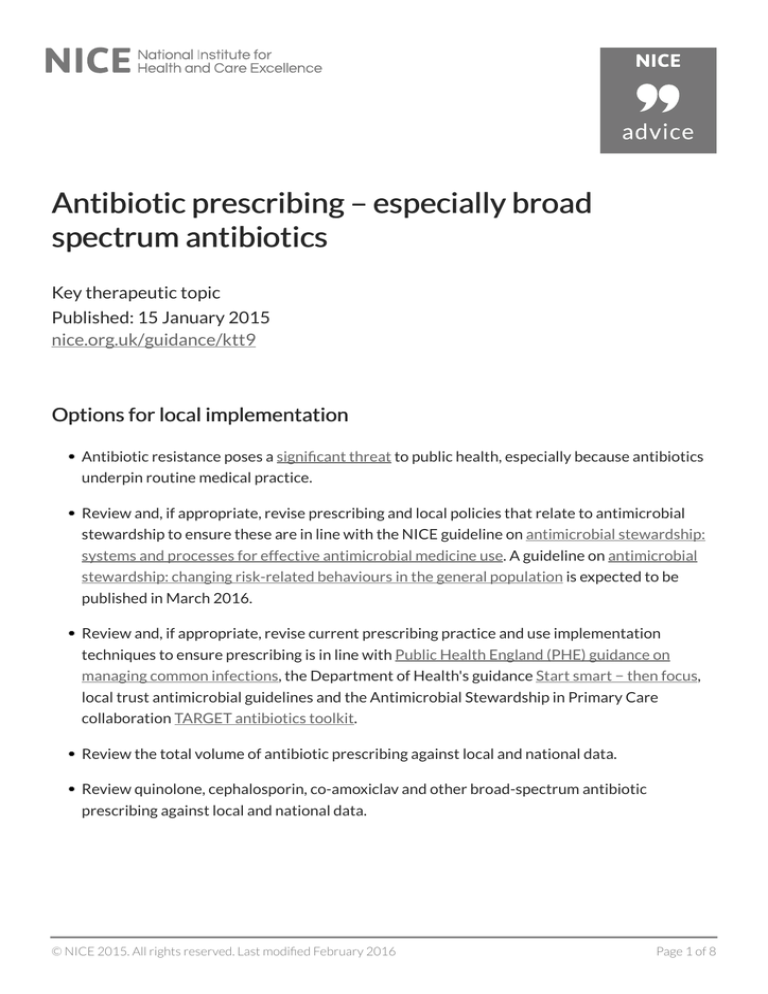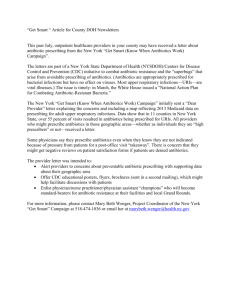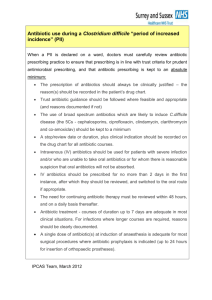
pat hways
Antibiotic prescribing – especially broad
spectrum antibiotics
Key therapeutic topic
Published: 15 January 2015
nice.org.uk/guidance/ktt9
Options for local implementation
Antibiotic resistance poses a significant threat to public health, especially because antibiotics
underpin routine medical practice.
Review and, if appropriate, revise prescribing and local policies that relate to antimicrobial
stewardship to ensure these are in line with the NICE guideline on antimicrobial stewardship:
systems and processes for effective antimicrobial medicine use. A guideline on antimicrobial
stewardship: changing risk-related behaviours in the general population is expected to be
published in March 2016.
Review and, if appropriate, revise current prescribing practice and use implementation
techniques to ensure prescribing is in line with Public Health England (PHE) guidance on
managing common infections, the Department of Health's guidance Start smart − then focus,
local trust antimicrobial guidelines and the Antimicrobial Stewardship in Primary Care
collaboration TARGET antibiotics toolkit.
Review the total volume of antibiotic prescribing against local and national data.
Review quinolone, cephalosporin, co-amoxiclav and other broad-spectrum antibiotic
prescribing against local and national data.
© NICE 2015. All rights reserved. Last modified February 2016
Page 1 of 8
Antibiotic prescribing – especially broad spectrum antibiotics (KTT9)
Evidence conte
context
xt
Antibiotic resistance poses a significant threat to public health, especially because antibiotics
underpin routine medical practice. The Chief Medical Officer's report on the threat of antimicrobial
resistance and infectious diseases (March 2013) highlights that, while a new infectious disease has
been discovered nearly every year for the past 30 years, there have been very few new antibiotics
developed. This is leaving the armoury nearly empty as diseases evolve and become resistant to
existing drugs. The report highlights that looking after the current supply of antibiotics is equally as
important as encouraging development of new drugs.
To help prevent the development of resistance it is important to only prescribe antibiotics when
they are necessary, and not for self-limiting mild infections such as colds and most coughs, sinusitis,
earache and sore throats. A study, which was outlined in a NICE medicines evidence commentary,
Antibiotic prescribing: study suggests there is scope for improvements, measured trends in
antibiotic prescribing in UK primary care in relation to nationally recommended best practice. It
found that antibiotic prescribing for coughs and colds increased from 36% in 1999 to 51% in 2011,
with marked variation between practices (range 32% to 65%), despite government
recommendations to reduce prescribing for self-limiting mild infections. In addition, in 2011,
recommendations in the Public Health England (PHE) guidance on managing common infections
about choice of antibiotic were not followed for 31% of sore throats.
PHE guidance on managing common infections recommends that consideration should be given to
a no, or back-up or delayed antibiotic strategy for acute self-limiting upper respiratory tract
infections, and mild urinary tract infections (UTIs). It also advises that people are given supporting
information about antibiotic strategies, infection severity and usual duration.
The PHE guidance also recommends that simple generic antibiotics should be used if possible when
antibiotics are necessary. Broad-spectrum antibiotics (for example, co-amoxiclav, quinolones and
cephalosporins) need to be reserved to treat resistant disease. They should generally be used only
when narrow-spectrum antibiotics are ineffective because they increase the risk of methicillinresistant Staphylococcus aureus (MRSA), Clostridium difficile and resistant urinary tract infections.
Although MRSA bacteraemias have decreased, this organism remains a serious threat, especially to
hospital inpatients. Addressing healthcare-associated Clostridium difficile infection also remains a
key issue on which NHS organisations have been mandated to implement national guidance. The
Department of Health and Public Health England's report on Clostridium difficile infection: how to
deal with the problem from 2008 recommends that trusts should develop restrictive antibiotic
guidelines that use narrow-spectrum agents alone or in combination as appropriate. The report
© NICE 2015. All rights reserved. Last modified February 2016
Page 2 of 8
Antibiotic prescribing – especially broad spectrum antibiotics (KTT9)
suggests that these guidelines should avoid recommending clindamycin and second- and thirdgeneration cephalosporins (especially in older people) and should recommend minimising the use
of quinolones, carbapenems (for example, imipenem and meropenem) and prolonged courses of
aminopenicillins (for example, ampicillin and amoxicillin). Broad-spectrum antibiotics should be
used only when indicated by the person's clinical condition, and their use should be reviewed after
the results of microbiological testing or based on the sensitivities of causative bacteria.
The Department of Health Advisory Committee on Antimicrobial Resistance and Healthcare
Associated Infection (ARHAI) recommends the Start smart − then focus approach. This
recommends that, if immediate antibiotic treatment is necessary, the clinical diagnosis and
continuing need for antibiotics should be reviewed within 48−72 hours. A study of Start smart −
then focus, which was discussed in a NICE eyes on evidence article Implementation of antibiotic
prescribing guidance, concluded that most hospital antibiotic policies in England 'start smart' by
recommending broad-spectrum antibiotics for empirical therapy in severe infections. However
fewer 'focus' by reviewing the ongoing need for antibiotics after a couple of days, as recommended.
A NICE evidence summary: medicines and prescribing briefing on Clostridium difficile infection:
risk with broad-spectrum antibiotics outlines 3 meta-analyses on this infection. The first of these,
Slimings and Riley (2014), concluded that cephalosporins and clindamycin are the antibiotics most
strongly associated with hospital-associated C. difficile infection. Subgroup analyses showed that,
although first-generation cephalosporins appear to carry a lower risk of C. difficile infection than
second- or third-generation cephalosporins, there is no definitive evidence to prove this. Also, coamoxiclav and piperacillin-tazobactam were associated with an increase in the risk of infection. The
other 2 meta-analyses, Brown et al. (2013) and Deshpande et al. (2013), found that, for communityassociated infection, the strongest association was seen with clindamycin, cephalosporins and
quinolones. Trimethoprim and sulfonamides (co-trimoxazole) were associated with an increased
risk of infection in all 3 meta-analyses but data were not reported for trimethoprim alone, which is
most commonly used in England. The 3 meta-analyses have many limitations and, because of those
limitations and the observational nature of the studies, they cannot definitively establish a causal
relationship between particular antibiotics and C. difficile infection. Changes in antibiotic
prescribing practice, the frequent use of multiple antibiotics and other potential confounding
factors make it difficult to determine the relative risk for individual antibiotics.
Public Health England's English surveillance programme antimicrobial utilisation and resistance
(ESPAUR) report includes national data on antibiotic prescribing, antibiotic resistance and hospital
antimicrobial stewardship implementation. This shows that, in general practice, use of
cephalosporins and quinolones decreased, but use of co-amoxiclav significantly increased between
2010 and 2013. In hospitals, the use of narrow-spectrum antibiotics (phenoxymethylpenicillin,
© NICE 2015. All rights reserved. Last modified February 2016
Page 3 of 8
Antibiotic prescribing – especially broad spectrum antibiotics (KTT9)
flucloxacillin and erythromycin) decreased and the use of broad-spectrum antibiotics such as coamoxiclav, piperacillin-tazobactam and meropenem significantly increased during the same period.
The C. difficile ribotyping network (CDRN) report, published by Public Health England, found that
the strains of C. difficile identified and the antibiotics most frequently reported as being associated
with C. difficile infections referred to the CDRN have changed markedly. In 2007/08,
cephalosporins and quinolones were the most commonly cited antibiotics, but they were
superseded by co-amoxiclav and piperacillin-tazobactam in 2011/12 and 2012/13.
These data should be interpreted with caution and should not be considered to indicate
conclusively which antibiotics have the highest risks of C. difficile infection. Nevertheless, they show
that antibiotic prescribing practice and the epidemiology of C. difficile infections are changing. The
NICE evidence summary concludes that, without clear evidence showing that 1 particular
antibiotic or class of antibiotic is 'low-risk', only general recommendations are possible and
healthcare professionals should follow antibiotic guidelines that recommend that all broadspectrum antibiotics are prescribed appropriately and with careful stewardship.
According to PHE guidance on managing common infections, cefalexin and other cephalosporins
(cefixime, cefotaxime and ceftriaxone) should be used only in limited situations (for example,
second-line in upper and lower UTI in children, and third-line in UTI in women who are pregnant).
Clindamycin is recommended only for bacterial vaginosis (as a vaginal cream) and is an option for
cellulitis and dental abscess in people with penicillin allergy.
The prescribing of quinolones (for example, ciprofloxacin and ofloxacin) in general practice is also a
cause for concern. Resistance to quinolones has increased at a considerable rate (for example,
quinolone-resistant Neisseria gonorrhoeae) and is usually high level, affecting all the quinolones (see
Susceptibility testing of N. gonorrhoeae for details). PHE guidance on managing common infections
recommends that quinolones are used as first-line treatment only for acute pyelonephritis, acute
prostatitis, epididymitis and pelvic inflammatory disease. It states that they should be used in lower
respiratory tract infections only when there is proven resistance to other antibiotics.
Although identifying the cephalosporin and quinolone classes as 'high-risk' may have been an
important control measure in reducing the risk of C. difficile infection, an unintended consequence
of this may have been a recent increase in clinically inappropriate prescribing of co-amoxiclav and
other broad-spectrum antibiotics, such as piperacillin-tazobactam. These antibiotics have a very
limited set of recommended clinical indications. According to the PHE guidance, co-amoxiclavis
recommended only for persistent acute rhinosinusitis, upper UTI in children, acute pyelonephritis,
facial cellulitis, and the prophylaxis and treatment of infection after bites. It may be used second-
© NICE 2015. All rights reserved. Last modified February 2016
Page 4 of 8
Antibiotic prescribing – especially broad spectrum antibiotics (KTT9)
line in acute exacerbations of chronic obstructive pulmonary disease if infection is resistant to firstline options. Piperacillin-tazobactam is an intravenous antibiotic and is not generally used in
primary care. However, according to the ESPAUR report, it has become 1 of the top 5 antibiotics
recommended in empiric guidelines for 10 common infections in NHS acute trusts.
Co-trimoxazole is not recommended in PHE guidance for primary care for any infections, nor does
it appear in the list of antibiotics most commonly recommended in empiric guidelines for
10 common infections in NHS acute trusts. However, anecdotal evidence suggests use is increasing.
The British National Formulary advises that co-trimoxazole is associated with rare but serious side
effects (for example, Stevens-Johnson syndrome, bone marrow depression and agranulocytosis)
and states that it should only be considered for UTI and acute exacerbations of chronic bronchitis
when there is bacteriological evidence of sensitivity to co-trimoxazole and good reason to prefer
this combination to a single antibacterial; similarly it should only be used in acute otitis media in
children when there is good reason to prefer it.
The Department of Health website has information on antibiotic resistance, and resources to help
reduce inappropriate antibiotic prescribing. See also the TARGET antibiotics toolkit, which was
developed by the Antimicrobial Stewardship in Primary Care collaboration (from several
organisations including the Royal College of General Practitioners and PHE). The website provides
several tools to help clinicians and commissioners use antibiotics responsibly, including patient
information leaflets and posters, clinician training resources (including e-learning modules on
managing acute respiratory tract infections and UTIs) and audit templates. In secondary care, the
Department of Health's Start smart − then focus is recommended.
More information on managing common infections can be found in the NICE guideline on
respiratory tract infections, the NICE guideline on pneumonia, the NICE pathway on self-limiting
respiratory tract infections – antibiotic prescribing and the MeReC bulletin on managing common
infections in primary care.
A NICE guideline on antimicrobial stewardship: systems and processes for effective antimicrobial
medicine use was published in August 2015 and a guideline on antimicrobial stewardship: changing
risk-related behaviours in the general population is expected to be published in March 2016. A
NICE pathway on prevention and control of healthcare-associated infection brings information on
this subject together.
NICE has also published quality standards on infection prevention and control and surgical site
infection, which are concise sets of prioritised statements designed to drive measurable quality
improvements within these areas.
© NICE 2015. All rights reserved. Last modified February 2016
Page 5 of 8
Antibiotic prescribing – especially broad spectrum antibiotics (KTT9)
Prescribing data
The Advisory Committee on Antimicrobial Resistance and Healthcare Associated Infection
(ARHAI), which provides advice to the government on minimising the risk of healthcare associated
infections, has agreed antimicrobial prescribing quality measures for primary and secondary care.
NHS England's Planning guidance for 2015/16 for NHS foundation trusts includes a national
quality premium measure on antibiotics for clinical commissioning groups.
Two prescribing comparators are available to support this key therapeutic topic[ ]. These are:
1
Antibacterial items/ST
items/STAR-PU:
AR-PU: the number of prescription items for antibacterial drugs (BNF
5.1) per Oral antibacterials (BNF 5.1 sub-set) ITEM based Specific Therapeutic Group Age-sex
weightings Related Prescribing Unit (STAR-PU).
Co-amo
Co-amoxicla
xiclavv, cephalosporins & quinolones % items: the number of prescription items for coamoxiclav, cephalosporins and quinolones as a percentage of the total number of prescription
items for selected antibacterial drugs (BNF 5.1).
Antibacterial items/STAR-PU
Data for 2014/15 (April 2014 to March 2015) show a 2.26 fold variation in prescribing rates at
Clinical Commissioning Group (CCG) level, from 0.68 to 1.53 items/STAR-PU.
Between Q4 2013/14 (January 2014 to March 2014) and Q4 2014/15 (January 2015 to
March 2015) there was a 0.64% increase in the comparator value for England (total
prescribing) from 0.314 to 0.316 items/STAR-PU.
Over the same period there was a 5.68% increase in the variation between CCGs, as measured
by the inter-decile range, an absolute increase of 0.005 items/STAR-PU. The inter-decile range
is the difference between the highest and lowest values after the highest and lowest 10% of
values have been removed.
Co-amoxiclav, cephalosporins & quinolones % items
Data for 2014/15 (April 2014 to March 2015) show a 4.1 fold variation in prescribing rates at
CCG level, from 4.4% to 18.0%.
Between Q4 2013/14 (January 2014 to March 2014) and Q4 2014/15 (January 2015 to
March 2015) there was a 6.4% decrease in the comparator value for England (total
prescribing) from 10.6% to 9.9%.
© NICE 2015. All rights reserved. Last modified February 2016
Page 6 of 8
Antibiotic prescribing – especially broad spectrum antibiotics (KTT9)
Over the same period there was a 6.4% decrease in the variation between CCGs, as measured
by the inter-decile range, an absolute decrease of 0.47%. The inter-decile range is the
difference between the highest and lowest values after the highest and lowest 10% of values
have been removed.
The medicines optimisation dashboard, which brings together a range of medicines-related quality
indicators from across sectors, includes the 2 prescribing comparators outlined above. The
medicines optimisation dashboard helps NHS organisations to understand how well their local
populations are being supported to optimise medicines use and inform local planning. The
dashboard allows NHS organisations to highlight variation in local practice and provoke discussion
on the appropriateness of local care. It is not intended as a performance measurement tool and
there are no targets.
[1]
The comparator and associated data presented here are based on the previous Key therapeutic
topics publication (January 2015). Data provided by the Health and Social Care Information Centre
(October 2015; source: Information Services Portal, Business Services Authority). For details of
any update to the comparators refer to the Health and Social Care Information Centre website and
the Information Services Portal, Business Services Authority.
Update information
February 2016 This topic was retained for the 2016 update of Medicines optimisation: key
therapeutic topics. The evidence context has been updated in the light of new guidance and
important new evidence as appropriate.
About this k
ke
ey ther
therapeutic
apeutic topic
This document summarises the evidence base on this key therapeutic topic which has been
identified to support Medicines Optimisation. It is not formal NICE guidance.
For information about the process used to develop the Key therapeutic topics, see the integrated
process statement.
Cop
Copyright
yright
© National Institute for Health and Care Excellence, 2016. All rights reserved. NICE copyright
material can be downloaded for private research and study, and may be reproduced for educational
© NICE 2015. All rights reserved. Last modified February 2016
Page 7 of 8
Antibiotic prescribing – especially broad spectrum antibiotics (KTT9)
and not-for-profit purposes. No reproduction by or for commercial organisations, or for
commercial purposes, is allowed without the written permission of NICE.
ISBN: 978-1-4731-0942-1
© NICE 2015. All rights reserved. Last modified February 2016
Page 8 of 8






